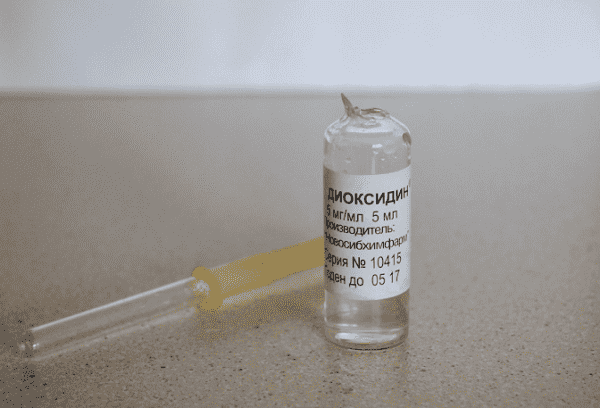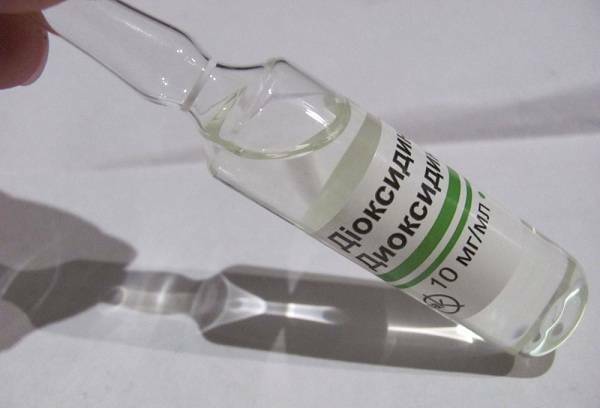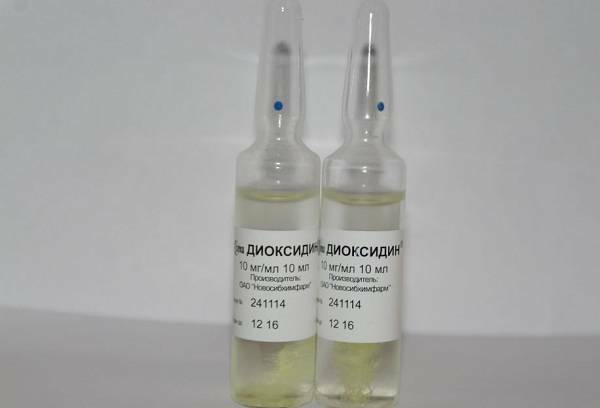Content:
- What is Dioxydin, and in what cases is it used?
- How correctly to use and store the drug in ampoules?
- How to store the formulation as an ointment?
- Side effects from the use of the expired product
Any antibacterial agent shows its effectiveness only if the proper approach to its storage and use is made. That's why you need to know how to store Dioxydin - a drug that has an impressive list of therapeutic properties.

This product is able not only to effectively combat inflammatory processes and inhibit the activity of common microorganisms. He can help with purulent infections, prevent possible complications after operations, resist the pathogens that have acquired resistance to antibiotics and chemical reagents.
At the same time, Dimexidine can cause side effects if it is used incorrectly or uncontrolled. The same unpleasant consequences are fraught with the use of a product subjected to improper storage after opening.
What is Dioxydin, and in what cases is it used?
Regardless of the form of the release( solution in ampoules or ointment), the Dioxydin drug acts on the DNA of a pathogenic bacterium, destroying it from the inside. Due to this, the process of suppressing inflammation is accelerated, the damaged tissues are rapidly restored.

The ampoule form of the product can be used in the following conditions:
- Purulent inflammatory pathological processes caused by the activity of bacteria( sepsis, peritonitis).
- Inflammatory processes of the bladder.
- Purulent meningitis, lung abscess.
- Diseases of the gums( stomatitis) and lesions of the skin( abscesses, burns, bites, carbuncles, phlegmon).
- Often, Dioxydin is used in otitis media, in the absence of efficacy from traditional treatment. In this case, after the ear canal is cleared of sulfur and pus( in difficult cases), a solution is injected in it or ointment is put in it.
- Flushing of the nasal passages with Dioxydin solution helps to eliminate signs of complicated rhinitis, sinusitis, protracted rhinitis. Despite its effectiveness, the product acts very gently, without compromising the integrity of the mucous membrane.
Dioxydin in the form of an ointment or ampoule solution can be used after operations for the treatment of scars, wounds and stitches, which can not be provided with quality care and there is a risk of suppuration.

How correctly to use and store the drug in ampoules?
Dioxydin solution is available in two concentrations, and the work with it depends on how much of the active ingredient is on the package. If it is 0.5%, then you do not need to dilute the product, it is ready for use.1% saturated product is preliminarily diluted with water for injection or hydrocortisone. You can do this yourself, you only need to withstand the proportions.
Advice: Despite the obvious effectiveness and softness of the effect, Dioxydin, available in ampoules, should only be used under the supervision of a doctor. Abuse of the product, especially with intravenous and intracavitary administration, can be addictive, which is not easy to get rid of.
Store Dioxydin in the form of closed ampoules is very simple, it is not too demanding. Shelf life of the product is 24 months. It is best to place it in a dark place inaccessible to children, where the temperature is maintained from 5 to 25 ° C.Before using the product, the ampoule must be examined in the light, small crystals can form in the solution. In this case, it must be heated on a steam bath, holding as much as necessary to completely dissolve the particles.

It is better not to use the opened ampoule in the future. In extreme cases( for example, if there is a shortage of the product), it is allowed to leave it for the next day, pre-sealing the hole with a sterile cotton wool. There is another convenient way to store an open product - it is simply typed in a syringe until the next time.
How to store the formulation as an ointment?
The requirements for storing the ointment in a closed tube are exactly the same. Once the product has been opened, it should be used within the specified period of therapy. If the treatment is completed, and the composition is still left, it can be carefully closed and cleaned for further storage. Regardless of how much time passes after this, before the next use Dioxydin should be checked for changes in color, texture, appearance of a specific odor. If any of the above is found, then it is better not to use the tool in the future.

Side effects from the application of the expired product
Negative effects can be very different, but most often these are the same reactions that are highlighted by specialists in the form of side effects from the therapy. With intravenous and intracavitary administration it is:
- Headache against a background of chills.
- Dyspeptic disorders in the form of nausea, vomiting and diarrhea.
- Febrile states.
- Appearance of convulsive twitching of individual muscles or whole groups.
- Formation on the skin of pigment spots as a result of direct exposure to ultraviolet light.
- Various allergic reactions.
Topical application of expired Dioxydin usually leads to the appearance of itching or the development of dermatitis on the treated surface. If at least one of these conditions develops, even if the manifestations are weak and are normally tolerated by the patient, you should immediately consult a doctor for advice.



